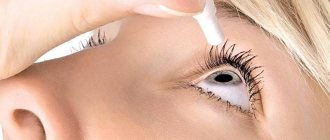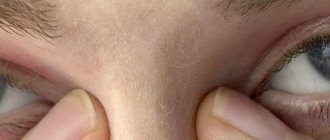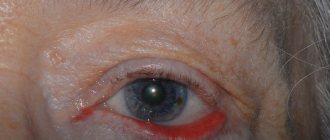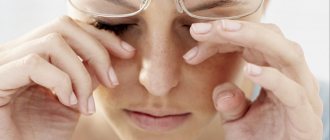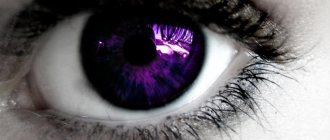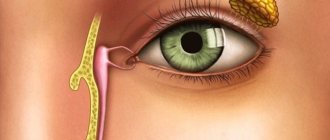Faced with nearsightedness or farsightedness, many people do not want to wear glasses because they are embarrassed by them and believe that glasses spoil their appearance. Then the ophthalmologist may recommend contact lenses to the patient. Moreover, it is almost impossible to select them without the help of a specialist.
The lens is inserted under the eyelids, in contact with the mucous membranes of the eyes, and for each patient you need to choose the most suitable brand and size of lenses for him. Most often, young people use lenses, since at this age everyone wants to look as good and attractive as possible to the opposite sex. In addition, everyone will be pleased by the absence of the need to carry a case with glasses and feel their pressure on the bridge of the nose. However, when wearing lenses, especially if you do not follow the rules for using them, dry eyes may occur.
Symptoms of dry eye
Dry eyes when wearing contact lenses brings great discomfort to a person and manifests itself in the following form:
- irritation and redness of the eyes;
- burning, stinging sensation, pain, itching, tingling;
- increased lacrimation;
- feeling of a foreign object in the eyes;
- decreased clarity, visual acuity, blurred image;
- dry eyes;
- photophobia.
Important! If all or some of the symptoms persist, you should consult an ophthalmologist. Self-medication will only make the problem worse.
Why does discomfort occur?
A person using contact lenses must strictly adhere to the rules of their use; improper handling can significantly harm the visual organ. To prevent the lens from rubbing the mucous membrane, it is necessary to remove them in time. Neglect of wearing rules provokes the development of corneal hypoxia. The causes of side effects may be an allergic reaction, mechanical damage, or chemical injury.
Diseases of the visual organ
Incorrectly selected contact lenses threaten the development of conjunctivitis, dry eye syndrome, and can cause inflammation, acanthamoeba keratitis, and corneal ulcers. One small injury during use, an insufficiently clean or damaged lens contributes to the occurrence of erosion on the eye cornea and wounds on the eyelids. Long-term wearing of poorly permeable night lenses causes pain and hypoxia of the eye, which is fraught with the development of neoplasms of the corneal vessels. Exceeding the service life threatens the patient with follicular conjunctivitis and severe blurred vision. Microbial keratitis can cause complete loss of visual function. If, while wearing a corrective product, pain systematically occurs in the right eye, the lenses rub, or the patient sees cloudy objects, then these symptoms cannot be ignored and you must immediately seek medical help.
Allergic reaction
At the first sign of an allergy, it is recommended to consult a doctor.
A person may experience individual incompatibility between the material from which the lenses were made and the individual components included in the care solution. When there is a sting in the eye, pain is felt or other symptoms are observed, you need to consult a doctor who will help you individually select substitutes and prescribe suitable antihistamines.
If your eyes hurt, you should immediately consult an ophthalmologist. It must be remembered that failure to seek medical help in a timely manner can lead to irreversible consequences. The sooner you start treatment, the easier it is to get rid of the manifestations of the disease.
Chemical exposure
If regular and colored lenses are not properly treated with a cleaning solution, it is possible to get chemical burns to the eyeball, which causes severe pain in the eye. Most disinfectants contain hydrogen peroxide, which must be carefully removed from the surface. Before using the liquid, it is recommended to carefully study the instructions.
Mechanical damage
To avoid problems, lenses must be selected together with an optometrist.
Due to an incorrectly selected diameter or fit of the contact lens, there is a risk of microtrauma to the mucosa. The patient will feel pain in the eyes, feel like something is pricking, it hurts, the lenses have rubbed the surface of the eyeball, and will notice the formation of ulcers on the sides. To avoid these unpleasant side effects, CL should be selected by an ophthalmologist or optometrist.
Causes of dry eyes when wearing contact lenses
Dry eyes (dry eye syndrome) occurs when there is decreased tear production and insufficient hydration of the surface of the eye. This occurs as a result of the lens drying out the cornea of the eye. As a result, the eyes become sensitive to air, wind, and smoke.
There are quite a few direct causes of dry eyes and not all of them are interconnected:
- prolonged wearing of unsuitable lenses, individual intolerance;
- wearing lenses longer than prescribed, violating the wearing regime;
- failure to comply with hygiene rules when working with lenses;
- long work at the computer or TV;
- unfavorable environmental conditions: smoke, smog, dust;
- malnutrition;
- metabolic disorders, vitamin deficiency;
- dry air due to air conditioning or heating;
- medications (anti-allergenic drugs, antidepressants);
- various eye diseases.
Dangers of Dry Eyes When Wearing Lenses
In addition to causing significant discomfort, dry eyes while wearing contact lenses can have serious consequences. But fortunately, they only develop if you completely ignore the signs of this problem - and this is quite difficult.
In advanced cases of dry eye, conjunctivitis and changes in the cornea of the eye may occur. Due to reduced immunity, the eyes often become inflamed and become infected. Corneal ulcer, edema, iritis, corneal erosion, and corneal staining are also possible.
Important! With prolonged dry eyes and wearing lenses at this time, there may be a temporary deterioration in visual acuity, blurred vision, glare, photophobia, and redness of the eyes.
What to do?
Moisturizing drops, the choice of which is very large, will help get rid of dry eyes. The main thing is to choose those that are compatible with contact lenses, as they can differ significantly from regular lenses. Their main feature is that due to their composition, namely the content of moisturizing agents, the eye tissues are deeply nourished and the lenses themselves are moisturized. Some drops for dry eyes are aimed more specifically at moisturizing contact lenses.
Some of the best eye drops are those that contain sodium hyaluronate. It has a fairly viscous structure, which ensures a longer action of the drops and contributes to a longer period of tear film rupture. It is better that the drops do not contain preservatives, as they can lead to allergies.
It is equally important to choose the right lenses themselves. Many people think that if dry eyes occur, they should buy lenses with more moisture content. But this opinion is wrong. Such lenses lose most of this moisture when certain weather conditions occur, and then begin to take the missing water from the surface of the eye, thereby further exacerbating the problem.
For eyes suffering from dryness and pain, lenses made from hydrogel silicone are better suited. They perfectly transmit oxygen, which is so necessary for the cornea and the proper functioning of the tear film.
If dry eye symptoms do not go away even with the use of auxiliary products, you should immediately consult an ophthalmologist. In some cases, serious treatment and refusal to wear contact lenses will be required, replacing them with glasses. Health is more important than the aesthetic side of the issue.
A problem such as dry eyes from lenses is a very common phenomenon that requires special attention, because without good vision a person cannot lead an active life. Properly selected lenses, as well as solution and auxiliary drops, will make life more comfortable, and wearing lenses unnoticed.
The eyes are the main organ that shapes our worldview and guide us at all times. But now, due to monotonous routine work at computers, many people suffer from vision problems.
You have to resort to contact lenses. This is a great way to easily and quickly see the world in all its colors again. But dry eyes can prevent this. In this article, we will take a closer look at everything related to dry eyes when wearing lenses: symptoms, causes and treatments.
How to prevent dry eyes
Reading about the problems that dry eyes cause, you might think that wearing contacts is quite dangerous. But that's not true! By following simple measures, the possibility of complications is minimized:
- the first requirement is to follow the lens wearing regime and change them regularly;
- When you are not wearing lenses, place them in a special solution. This protects the lenses from drying out, damage and kills germs;
- Monitor the humidity level in the room, especially when operating the air conditioner and heater.
- Avoid drafts. Wear sunglasses in strong winds;
- While working at the monitor, take breaks by periodically closing your eyes or blinking quickly. This will help moisten the eyes with tears;
- do not smoke. Cigarette smoke contributes to the development of dry eyes by quickly evaporating moisture from their surface;
- use moisturizing drops and ointments. They prevent lenses from drying out and moisturize your eyes. We'll talk about them below.
Benefits of lenses
The reasons that make people wear lenses boil down to the following: cosmetic effect, optical benefits and healing properties. Many people with glasses have chosen contact vision correction for aesthetic and convenience reasons. In addition, lenses are used in the treatment of certain eye diseases.
Hard contact lenses
The first LCDs did not allow air to pass through, but now they are made gas-permeable. They are durable and resistant to mechanical damage. They are used to correct scar defects of the cornea and to treat astigmatism.
Soft contact lenses
Soft contact lenses are the most popular. They allow oxygen to pass through well and keep the cornea moist
However, it is very important to follow all prescribed precautions when using them, as there is a high risk of corneal infection and other complications.
Disposable
Models of this type are used only once and are called one-day ones. They reduce the risk of eye infections and require no maintenance. Once removed at the end of the day, they are simply thrown away.
Permanent
Permanent lenses are worn continuously for a month or for as long as recommended by the ophthalmologist. They have good breathability and moisture content, which allows the cornea to “breathe”. Such products are convenient for travel and in circumstances where it is difficult to take them off and put them on.
Therapeutic
CLs are used to correct refractive errors and in the treatment of certain diseases.
To correct astigmatism, toric contact lenses are used, multifocal contact lenses for presbyopia, and spherical contact lenses for myopia and farsightedness. Special cosmetic SCLs (colored lenses) with a pigment-colored periphery and a transparent center compensate for visual impairment in children born with aniridia (absence of the iris) or colomba (defect of the iris). With their help, photophobia is relieved, light is better directed to the retina, and the quality of vision improves.
Lenses for glaucoma
Glaucoma is treated with drops that promote the drainage of fluid from the eye or reduce its production. The problem is that only a few percent of the active substances remain in the eye and reach their target. Scientists changed their tactics: the therapeutic drug was introduced into the lens. The drug is released when it comes into contact with enzymes in the tear fluid, thus providing a permanent effect.
Help with dry eyes
Prevention and treatment of dry eyes is carried out using various moisturizers and folk methods.
Artificial tear preparations
They are used to additionally moisturize the cornea of the eye when there is a deficiency of tear fluid. Drops create a protective film on the surface of the eye and prevent tear evaporation. They are good for relieving symptoms of dryness, but can irritate the eyes if used frequently.
Artificial tear preparations vary in consistency. Thinner ones last less time than thick ones.
Before using the drops, the lenses are removed for 15 minutes and applied every few hours.
Eye ointments
Eye ointments have a more viscous consistency than drops. In doing so, they not only eliminate the symptoms, but also help cure the problem of dry eyes. Before using them, you need to remove your contact lenses for 15-20 minutes . They have greater effect when used at night. However, eye ointments are not recommended to be used together with drops.

